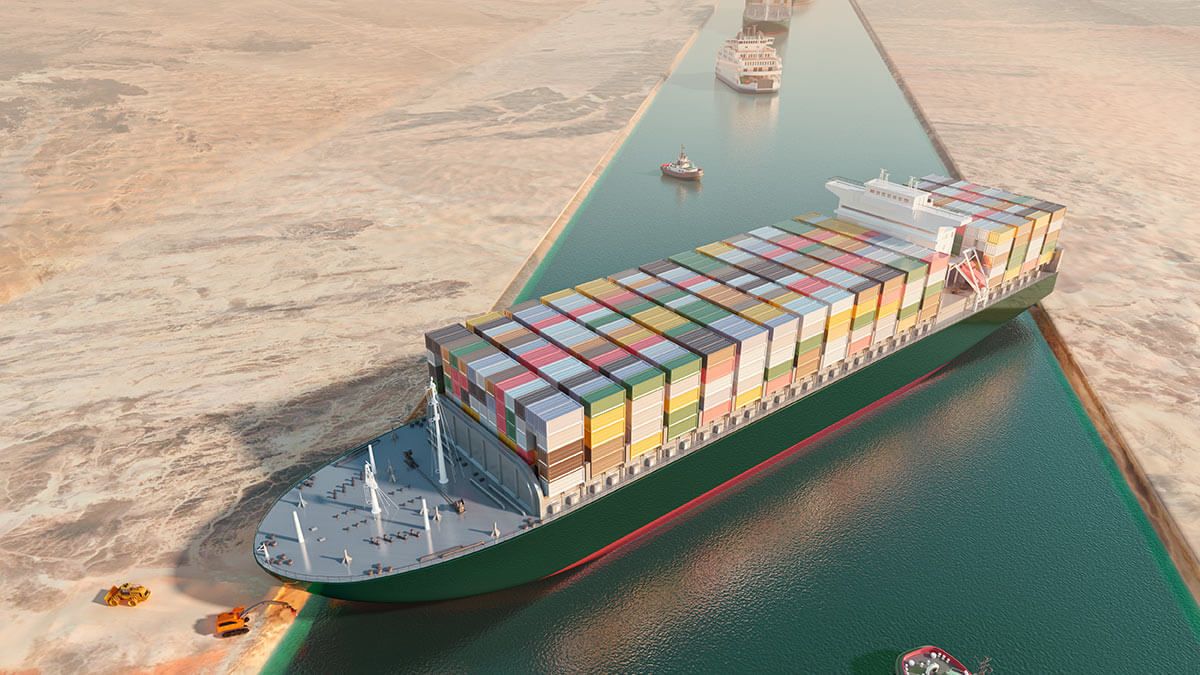BLOG
Telecom26 blog
Lessons From The Suez

According to this news piece, when the Ever Given container ship was finally dislodged: “Insurers, the shipping industry and the thousands of businesses reliant on container goods were still counting the cost of the accident as traffic resumed in the evening with more than 422 vessels, carrying a vast range of items from crude oil to cattle, waiting to cross”.
Apparently, this traffic jam is costing global trade between $6bn (£4.3bn) and $10bn a day according to the German insurer Allianz - with the state-owned Suez Canal Authority also losing about $16m a day in lost revenues.
“Many ships were rerouted around South Africa’s Cape of Good Hope in order to circumvent the Suez blockage, although the 5,500-mile (9,000km) diversion takes seven to 10 days longer and adds a huge fuel bill to the trip between Asia and Europe”.
The incident has added to the woes of supply chains already burdened by coronavirus delays which is something we wrote about last week: Congested ports and a shortage of containers affects global shipping market
The Ever Given is, quite simply, massive: 400m-long (1,312ft) weighing 200,000 tonnes, with a maximum capacity of 20,000 containers. It is currently carrying 18,300 containers.
In this BBC piece One UK company, Seaport Freight Services, said it had 20 containers of goods stranded on the Ever Given "We're waiting on food goods like coconut milk and syrups, some spare parts for motors, we've got some fork lift trucks, some Amazon goods on there, all sorts”.
Telecom26 - maximising maritime connectivity to enable communications between vessels - and enabling owners to monitor their cargo
There were a few different occasions when the Ever Given situation could have been improved if Telecom26’s team had been involved...
Firstly, our global connectivity service would have ensured that information about the accident was automatically routed back to all ships that were scheduled to move into the canal. Just-in-time supply chains necessitate reliable and secure communications.
Then all the container ships stuck in the jam on-board could - and should - have had sensors inside the containers carrying perishables. These would allow accurate estimates of how much time the goods had left - and determined re-routing patters to save the cargo accordingly.
In theory, the information could have even been sent to the mega shipping companies so that they could organise for their ships to go back into port to consolidate loads and optimize routes.
Putting our blue sky thinking hats on, we can imagine "virtual ports at sea" where ships could offload their cargo onto other ships (ie perishables) without needing to head into port. If our secure connectivity service was on-board the ships, logistics on the inventory and customers’ paperwork could be digitally transferred whilst sensors ensure that the cargo is never tampered with. Blockchain is also a vital component of this process in order to comply with Customs regulations.
Port Connectivity - IoT maritime connectivity and maritime cellular communications
Even before the Ever Given became a household name, port congestion and a shortage of containers and ships caused by COVID meant that it is even more vital to release capacity through the faster turnaround of vessels in-port.
Of course, effective communication - both voice and data - is more important than ever. Especially for fully automated ports where all devices are connected via IoT using a network of smart sensors and actuators, wireless devices, and data centres to enable port authorities to deal with larger ships, ever-increasing volumes of freight - and to bring together the entire shipping and logistics supply chain ecosystem.
Telecom26 provides IoT maritime connectivity and maritime cellular communications for ports - and the vessels that use them.
We’ve invested in dedicated technology to enable maritime and smart port solutions and can customise our offering to provide vessels, port personnel and infrastructure with the digital services, personal comms and IoT device data management they need to keep ships moving - and cargo safe and secure.
In addition, we provide offshore and nearshore maritime cellular communications for ferries, cruise liners, fishing vessels and more. We also enable private networks, both onshore – for ports – and offshore, to provide capacity onboard. Private networks can be bridged with public networks, but with full control, enabling a cohesive but managed service to be delivered.
So, we’re right at the leading edge of designing and enabling such solutions and understand the challenges that IoT and 5G coverage will bring – as well as the opportunities. Amidst all the excitement generated by 5G, it’s important to note that we can already enable many of these services via LTE, which means you don’t need to wait to benefit from the latest innovations in maritime and smart port technology.
To learn more about Telecom26’s suite of IoT maritime connectivity and maritime cellular communications services please click here.



